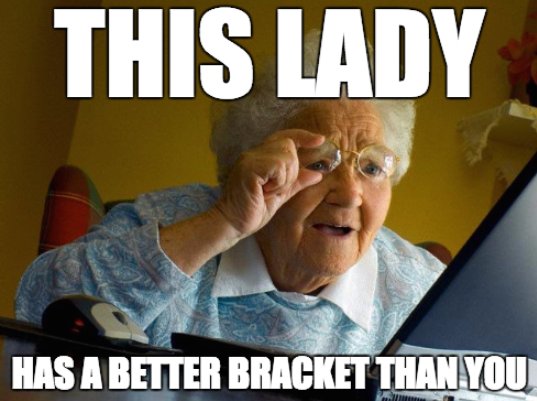
Bram Stoker meets the Bond Market
February 23, 2018
Leave it to Beaver
March 13, 2018Play the Odds

If you’re like me then you’re probably very excited this time of year due to the annual startup of the biggest roller coaster in all of sports, March Madness. Starting off with a conference championship week of the top ranked contenders defending their home court and looking to improve their seed while unranked mid majors look for that signature win which will punch their ticket into the big dance. Then after the conference champions are declared and the hope of those on the bubble are either dashed or dotted, the dance begins. Cue the All State commercial because as soon as that first game is tipped, the mayhem begins.
If you’re also like me then you’ll find yourself sitting down with a pen and printed bracket, penciling in those teams you think will win each week. More than 40 million Americans will submit a bracket whether it be a friendly neighborhood competition, a $25 buy in with the guys in the office or a ESPN official bracket submitted in hopes of winning Warren Buffett’s infamous $1 billion perfect bracket prize.
As a spectator, we enjoy these games for the action packed, high intensity environment where young student athletes compete in a ‘Hunger Games’ type tournament where the name of the game is simple; survive and advance. As a bracket owner, we stress and panic when the 3 seed we predicted to go to the Final Four needed double overtime to beat the 14 seed and we cringe when we watch the 12 seed beat the 5 seed in the game that the ESPN experts said was supposed to be a “lock”. Between the good, the bad and the Cinderellas the games are finalized, we throw away our brackets and the tournament of tournaments is concluded with One Shining Moment for the champion.
However, if we take a deeper dive into the odds of perfecting March Madness and compare it with other things in our daily life, it becomes almost laughable at how obscure the chances. Disregarding the fun and competitive aspect of filling out brackets with friends, if your goal was to truly create a perfect bracket for monetary benefit, according to Forbes, the odds are estimated to be ‘slightly’ over 1 in 9 quintillion. I didn’t even know that was a real number. Now, let’s write that out so we can visually see it. Your odds are slightly worse than 1 in this number 9,000,000,000,000,000,000.
Misinformed people might argue that “it’s like the same chance as winning the Powerball” when in fact it’s not even close. The average odds for winning the Powerball is around 1 in 250,000,000 which means you’re 36 billion times more likely to win the Powerball than you are to have a perfect bracket. However, a recent professor at DePaul University will save us all as he calculated that with reasonable decision making and knowledge of teams, that your odds are actually an astonishing 1 in 128 trillion, so only 500 times worse than your odds at the Powerball. Let’s put some statistics side by side to just visually see the numbers,
March Madness: 9,000,000,000,000,000,000 to 1
March Madness (favorable): 128,000,000,000 to 1
Powerball: 256,000,000 to 1
Struck by lightning: 700,000 to 1
Amateur golfer making a hole-in-one: 12,500 to 1
Finding a four-leaf clover: 10,000 to 1
Getting an 8% return on your investment: ????
Now obviously it is much more difficult to assign a relative probability to something as complex and complicated as the stock market. As with anything, there are times of highs and lows, and the basic goal is to capitalize to achieve profitable returns based on the rule of 72. Of course, the rule of 72 is a logarithmic equation designed to calculate the time for your investment to double. Typically, the rule of 72 states that your investment will double in approximately 9 years based on an average of 8% returns.
This 8% average is a result of over 100 years’ worth of returns from all sorts of markets.
1900s 9.96%
1910s 4.20%
1920s 14.95%
1930s -0.63%
1940s 8.72%
1950s 19.28%
1960s 7.78%
1970s 5.82%
1980s 17.57%
1990s 18.17%
2000s 1.07%
2010-2013 16.74%
So, if we are to take our own investment and give it a theoretical 8% average return where we might see a +/- 2% fluctuation based on better or worse years respectively and compare it to this chart of historical data, we are able to come up with a rough estimate of the odds in our favor. Investments are a product of patience and time, and so it is important to look at return rates in extended periods of time rather than in short increments. Based on our goal of an average of 8%, there are only two periods of time (1930’s and 2000’s) within the last 100 years where our return rate did not meet or exceed our goal of 8%. So, if taken literally, the odds of us receiving an 8% return on our investment would 8 in 10 odds or 80%. However, obviously by talking to the right people and paying attention to market swings and trends, one can likely generate on growing areas and avoid sinking ones thus greatly improving their overall odds. 
At the end of the day, the best way to gain more money is to save more money. So, if you are consistent, patient, and disciplined, simply by a $100 a month and compounding it at an 8% return rate, you can generate $60,000 within 20 years.
So next time you think about going to buy yourself 10 Powerball tickets, ask yourself, are you playing the odds correctly?


